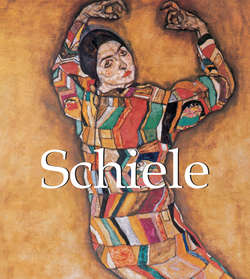Читать книгу Schiele - Ashley Bassie - Страница 2
На сайте Литреса книга снята с продажи.
Biography
ОглавлениеSchiele on his deathbed, 1918
1890: Birth of Egon Schiele in Tulln, Austria
1890–1900: Schiele devotes himself to drawing at a very young age, finding his first motifs in his native city and his surroundings.
1906: Schiele enters the Vienna Academy of Fine Arts.
1907: Meets Gustav Klimt. Klimt influenced Schiele’s first works and never ceased to encourage the young artist.
1908: Exhibition in Klosterneuburg.
1909: Rebels against the teachings of his Academy professor and he writes, along with several colleagues, a list of demands asking for greater freedom of artistic expression. Because of this incident, he is forced to leave the Academy. Schiele then founds the New Art group (Neukunstgruppe) along with artists like Anton Peschka and Hans Massmann. The group will hold their first exhibition at Vienna’s Pisko Salon. Thanks to Klimt, Schiele is invited to the prestigious International Exhibition of Vienna.
1910: Meets with Arthur Roessler, an art critic who presents Schiele to many collectors.
1911: Works in Krumau, Bavaria. He lives with one of his models, Wally Neuzil, offending the morality of the habitants of the small village. He then leaves for Neulengbach before settling down in Vienna in 1912.
1912: He exhibits in Budapest with the Neukunstgruppe and in Munich. Publication of his first lithograph. He is accused of the corruption of a minor, and is sentenced to three weeks in prison between March and April, a penalty that profoundly affects him. He then records his bitterness and revolts over his punishment in his Prison Journal, published by Arthur Roessler in 1922. In July, he presents at Cologne’s Sonderbund Exhibition, one of the most outstanding events of Austrian expressionism.
1913: He is admitted into the Bund Österreichischer Künstler (a league of Austrian artists) whose president is Gustav Klimt. In March, Schiele and the other artists in the league exhibit in Budapest. He then participates in the spring exhibition at the Munich Secession, at the Grosse Kunstausstellung in Berlin and at the forty-third exhibition at the Vienna Secession. He also contributes his writings and drawings to the Berlin review Die Aktion.
1915: Marriage of Egon Schiele and Edith Harms. The effects of this lifestyle change on Schiele can be seen in his work as his eroticism became less violent. Even though he had escaped from mobilisation, the medical commission returned to its decision and declared him fit for the front. He is drafted into the Austrian army. His artistic production decreased considerably.
1916: Schiele exhibits at the Berlin Secession and then at the Munich Secession. Die Aktion gives him a special issue.
1917: He returns to Vienna where he sits on the Imperial Commission. From now on, Schiele can spend his time focusing on painting. He creates the Kunsthalle, a free association of artists. He participates in an exhibition at Vienna’s Kaisergarten and then in various exhibitions in Amsterdam, Stockholm and Copenhagen. Schiele begins to contribute to the new Viennese movement, Der Anbruch.
1918: Death of Gustav Klimt on 6 February. Schiele’s participation in the Viennese Secession is a success for his financial and artistic plans. A number of Viennese personalities are interested in his ever-growing body of work and success. In the fall, his wife contracts the Spanish flu and dies on 28 October. Egon Schiele also contracts the virus, follows suit and falls ill, passing away on 31 October.
